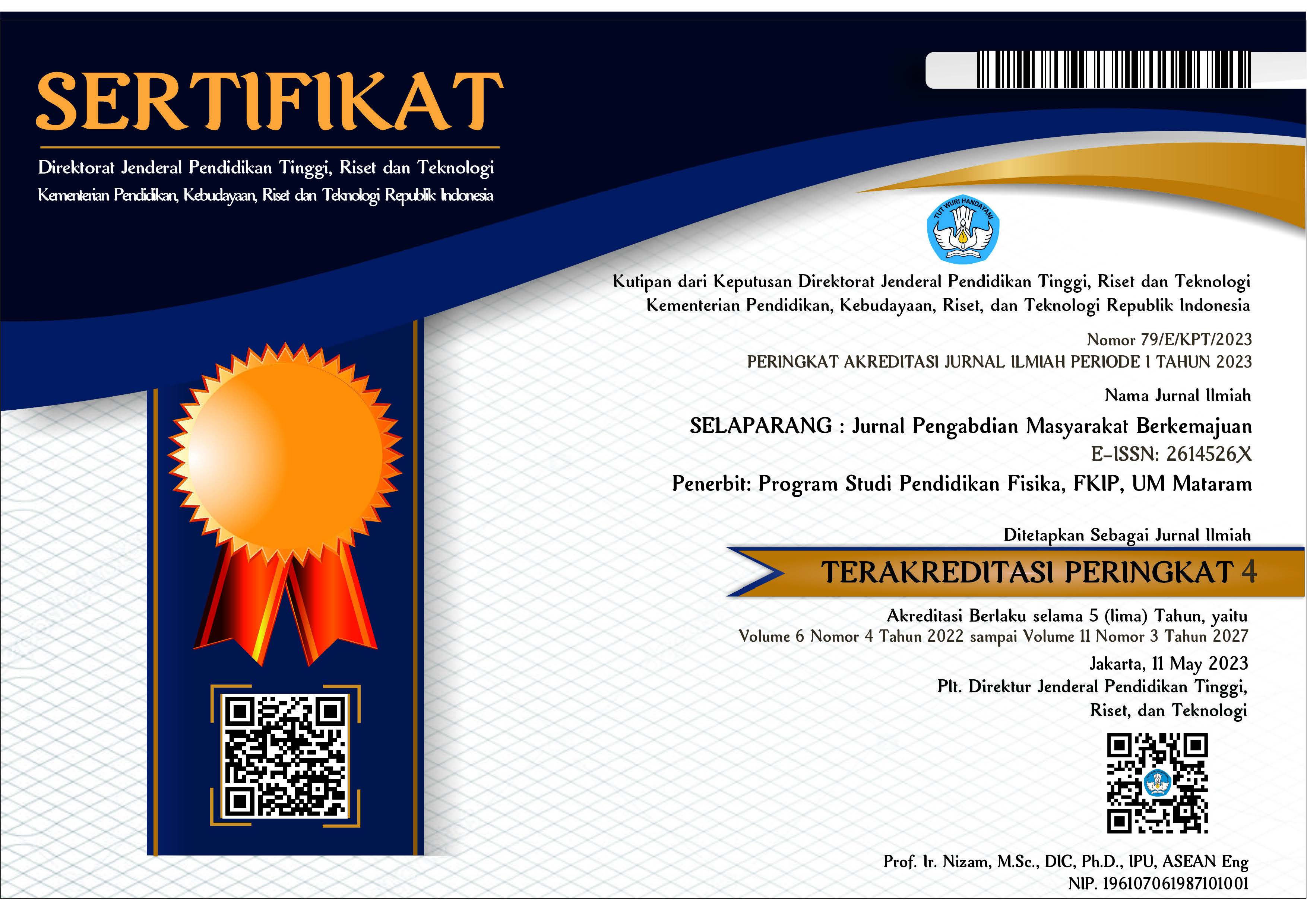PEMBENTUKAN PEER EDUCATOR DALAM UPAYA PENINGKATAN KUALITAS REMAJA MELALUI PEMBERIAN AKSES INFORMASI TENTANG PENDEWASAAN USIA PERKAWINAN DI DESA SEMBUNG KECAMATAN NARMADA KABUPATEN LOMBOK BARAT
Abstract
ABSTRAK
Permasalahan yang kami temukan di Desa Sembung yakni terdapat 29% perkawinan remaja. rata-rata pengetahuan remaja tentang dampak perkawinan muda masih sangat kurang, pelaksanaan perkawinan remaja masih didukung oleh budaya setempat, dan sebagian besar remaja yang telah melakukan perkawinan muda mengalami putus sekolah. Oleh sebab itu, kami membentuk peer educator tiap dusun untuk memudahkan remaja mengakses informasi terkait pendewasaan usia perkawinan. Hasil kegiatan ini sangat berdampak positif baik bagi remaja khususnya maupun orangtua dan masyarakat, terbukti 90% terjadi peningkatan pengetahuan dan sikap terhadap pendewasan usia perkawinan, sedangkan hasil uji lapangan sebesar 80% remaja mampu menjadi konselor sebaya (peer educator).
Kata kunci: perkawinan remaja, peer educator, pendewsaan usia perkawinan
ABSTRACT
The problem we found in Sembung Village is that there are 29% of teenage marriages. The collective knowledge of adolescents about the impact of young unions is still lacking, the implementation of underage marriages supported by local culture, and the majority of adolescents who have committed young marriages experience dropouts. Therefore, we formed peer educators in each hamlet to facilitate youth accessing information related to the age of marriage. The results of this activity are very favorable for both adolescents in particular as well as parents and the community, as evidenced by 90% increase in knowledge and attitudes towards the demise of marriage age, while field test results by 80% of adolescents can become peer educators.
Keywords: underage marriages, peer educator, related to the age of marriage
Keywords
Full Text:
PDFReferences
Child Protection Law no. 23/2002, article 26, 1 (c).
Gage, A.J. (2013). Association of child marriage with suicidal thoughts and attempts among adolescent girls in Ethiopia. Journal of Adolescent Health, 52, (5), p. 654; and Evenhuis and Burn, Just Married, Just a Child, p. 20.
ICRW. (2005). Development Initiative on Supporting Health Adolescents (DISHA) Project: Analysis of quantitative baseline survey data conducted in 2004. Washington, D.C: ICRW and Mathur, Greene and Malhotra. (2003). Too Young to Wed: The lives, rights and health of young married girls. Washington, D.C.: ICRW.
Kim, et al. 2013. When Do Laws Matter? National Minimum-Age-of-Marriage Laws, Child Rights, and Adolescent Fertility, 1989–2007. Law & Society Review, 47, (3), pp. 589, 591.
Marriage Law no. 1/1974, article 7 (1).
Minchew, Thompson and Kennedy. (2014). The Summer of the Summit – Now what for child, early and forced marriage? Girls Not Brides. Available from: http://www.girlsnotbrides.org/summer-summit-now-child-early-forced-marriage/, Accessed 28 January 2015.
RISTEKDIKTI. (2018). Buku Panduan Pelaksanaan Penelitian dan Pengabdian Kepada Masyarakat Edisi XII Tahun 2018. RISTEKDIKTI. Jakarta
Simanjuntak, H. (2015). Aceh student expelled from school over marriage. Jakarta: The Jakarta Post. Available from: http://www.thejakartapost.com/news/2015/01/23/aceh-student- expelled-school-over-marriage.html. Accessed 23 June 2015.
UNICEF. (2012). Progress for Children: A report card on adolescents: Number 10. New York: New York: UNICEF. p. 47.
United Nations General Assembly.(2014). The Road to Dignity by 2030: Ending poverty, transforming all lives and protecting the planet – Synthesis report of the Secretary-General on the post-2015 sustainable development agenda. New York: United Nations A/69/700; and United Nations General Assembly. Resolution Adopted by the General Assembly 69/XX: Child, early and forced marriage. Agenda Item 65(a), Version 14, New York: United Nations.
United Nations Children’s Fund. (2014). Ending Child Marriage: Progress and prospects. New York: UNICEF, p. 1.
WHO. (2014). World Health Statistics 2014. Geneva, Switzerland: World Health Organization; Raj, A. (2010). When the mother is a child: The impact of child marriage on the health and human rights of girls. Boston. Archives of disease in childhood. 95, (11), p. 931.
DOI: https://doi.org/10.31764/jpmb.v3i1.1065
Refbacks
- There are currently no refbacks.

This work is licensed under a Creative Commons Attribution-ShareAlike 4.0 International License.
______________________________________________________
Jurnal Selaparang
p-ISSN 2614-5251 || e-ISSN 2614-526X
EDITORIAL OFFICE:



















